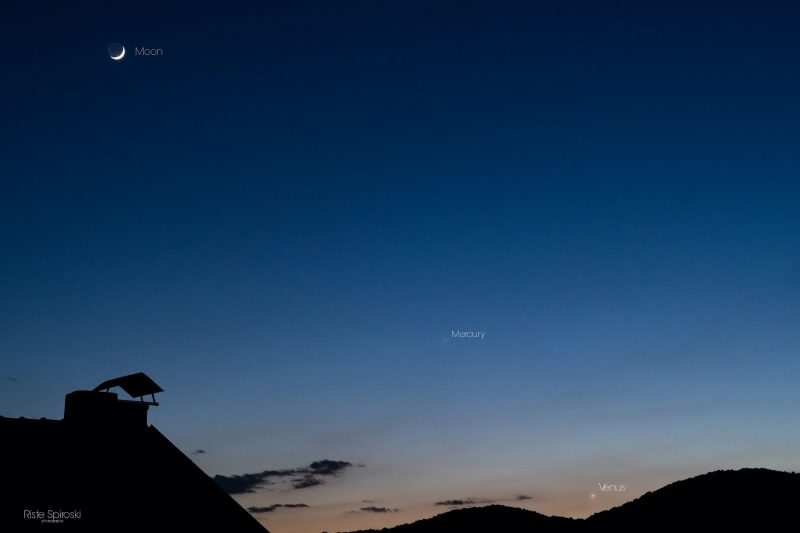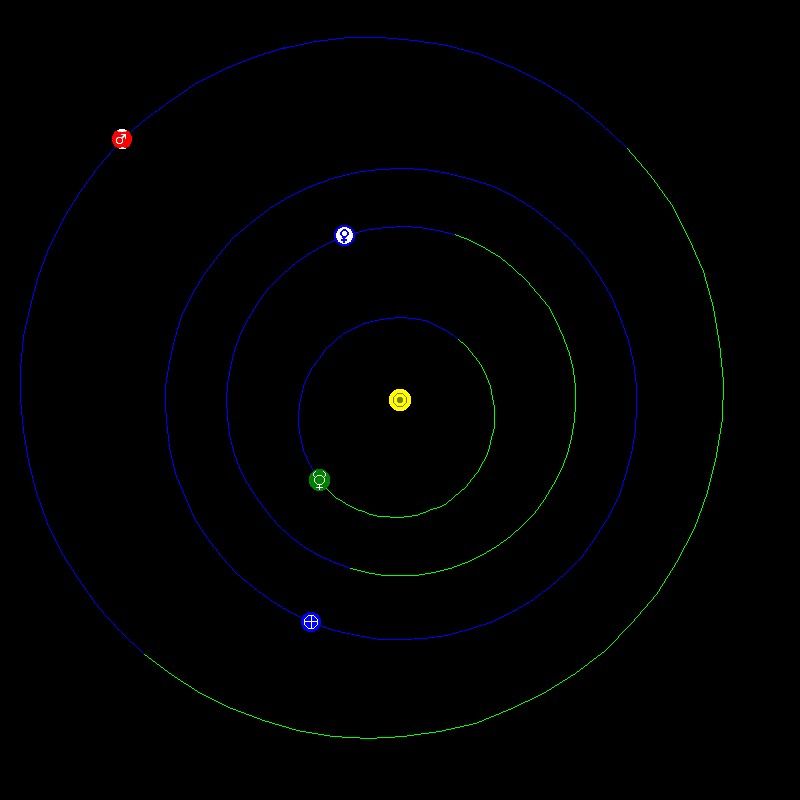
Late May 2021 presents the closest visible conjunction of the planets Mercury and Venus until November 5, 2033. No matter where you live worldwide, it’s to your advantage to find an unobstructed horizon in the direction of sunset. Watch for the planetary pair low in your western sky as evening dusk is ebbing toward night. Look for Venus, the much-brighter planet, to be visible to the eye alone some 30 to 40 minutes (if not sooner) after sunset.
Most likely, you’ll need an optical aid to view Mercury next to Venus; and even at that, Mercury might be hard to catch. Because Mercury is exhibiting a thin waning crescent phase right now (though you need a telescope to discern its phase), Mercury appears much dimmer now than at the beginning of the month. In early May, Mercury’s disk was over 80% illuminated by sunshine. By the month’s end, the illuminated portion will shrink to 10%, making Mercury around 40 times fainter now than in early May.

In short, don’t be be too surprised if you spot Venus with relative ease, but Mercury not at all. Venus ranks as the third-brightest celestial body to light up the heavens, after the sun and moon, respectively. Presently, Venus outshines Mercury by a few hundredfold.
Depending on where you live on the Earth’s globe, Mercury and Venus will come closest together at dusk on May 28 or 29, 2021. Both dates, however, will present Mercury and Venus plenty close together on the sky’s dome. If the weather cooperates, try both dates, and notice the slight change of position between the two worlds from one day to the next. At conjunction, Venus will pass a scant 0.4 degrees north of Mercury on May 29, at about 06:00 UTC. (For reference, the moon’s angular diameter spans about 0.5 degree.)
After their conjunction, Venus will continue to climb upward, away from the setting sun, but Mercury will sink sunward, eventually to meet up with the setting sun. Venus will remain in the evening sky for the rest of 2021, whereas Mercury will leave the evening sky to enter the morning sky on June 11, 2021. Mercury probably won’t be visible to the eye as a morning “star” until late June or July 2021.
Mercury and Venus stay out longer after sunset at more northerly latitudes and set sooner after sundown at more more southerly latitudes. We give you the approximate setting time for Venus, the brighter of these two planets, for the next few days at varying latitudes:
60 degrees north latitude
Venus sets about 1 3/4 hours (105 minutes) after sunset40 degrees north latitude
Venus sets about 1 1/3 hours (80 minutes) after sunsetEquator (0 degrees latitude)
Venus sets about 1 1/6 hours (70 minutes) after sunset35 degrees south latitude
Venus sets about one hour (60 minutes) after sunsetFor more specific information, consult Old Farmer’s Almanac if you live in the U.S. or Canada, or timeanddate.com for virtually anyplace worldwide.
By the way, these two worlds – Mercury and Venus – nearly coincide on the same line of sight, but are not truly close together in space. Astronomers often give the distances of solar system planets in terms of the astronomical unit (AU): the sun-Earth distance of about 93 million miles or 150 million km. At conjunction, Mercury resides 0.63 AU from Earth, whereas Venus lodges one astronomical unit beyond Mercury, at 1.63 AU.

Bottom line: Late May 2021 showcases the closest coupling of Mercury and Venus for years to come. Brilliant Venus boldly punctuates the evening twilight, but demure Mercury lurks at the threshold of visibility. You may well need binoculars for any chance of spotting Mercury, the innermost planet of the solar system. Good luck!











